Leadership and Management: Analysis of Styles and Globalisation Impact
VerifiedAdded on 2020/10/22
|11
|2694
|323
Report
AI Summary
This report provides a comprehensive analysis of leadership and management, focusing on the functional areas of an organization, communication's pivotal role, and the impact of globalization on business operations. It examines the functional areas of Arden Construction Ltd., highlighting the importance of marketing, finance, and human resources within the organizational structure. The report emphasizes the significance of internal and external communication for effective leadership and management, citing examples of how poor communication can negatively impact business outcomes. Furthermore, it delves into the current drivers of globalization, such as competition, technology, and cost, illustrating their effects on companies. Finally, the report compares and contrasts autocratic and democratic leadership styles, discussing their similarities, differences, and their respective impacts on organizational success. This report is designed to provide a detailed understanding of key leadership and management concepts.
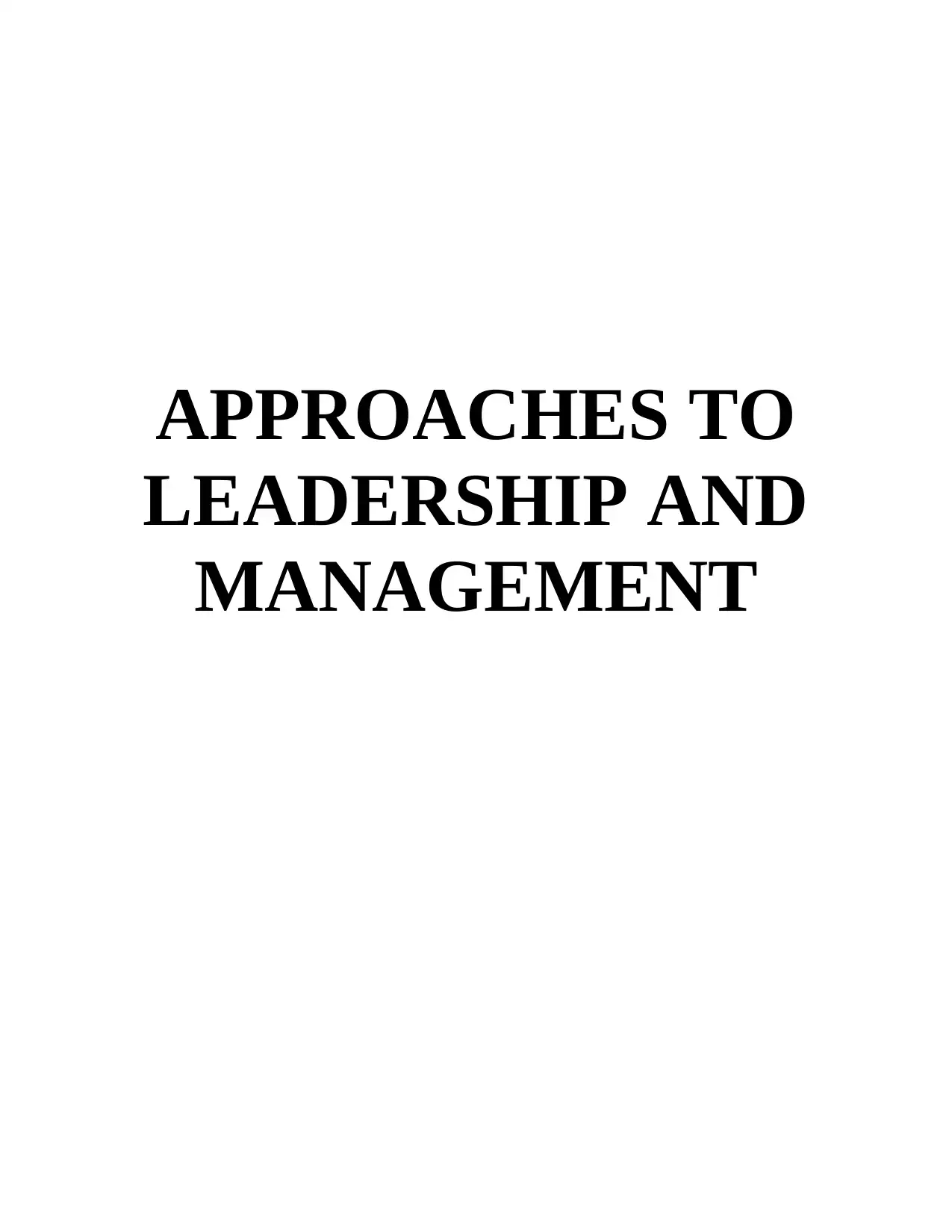
APPROACHES TO
LEADERSHIP AND
MANAGEMENT
LEADERSHIP AND
MANAGEMENT
Paraphrase This Document
Need a fresh take? Get an instant paraphrase of this document with our AI Paraphraser
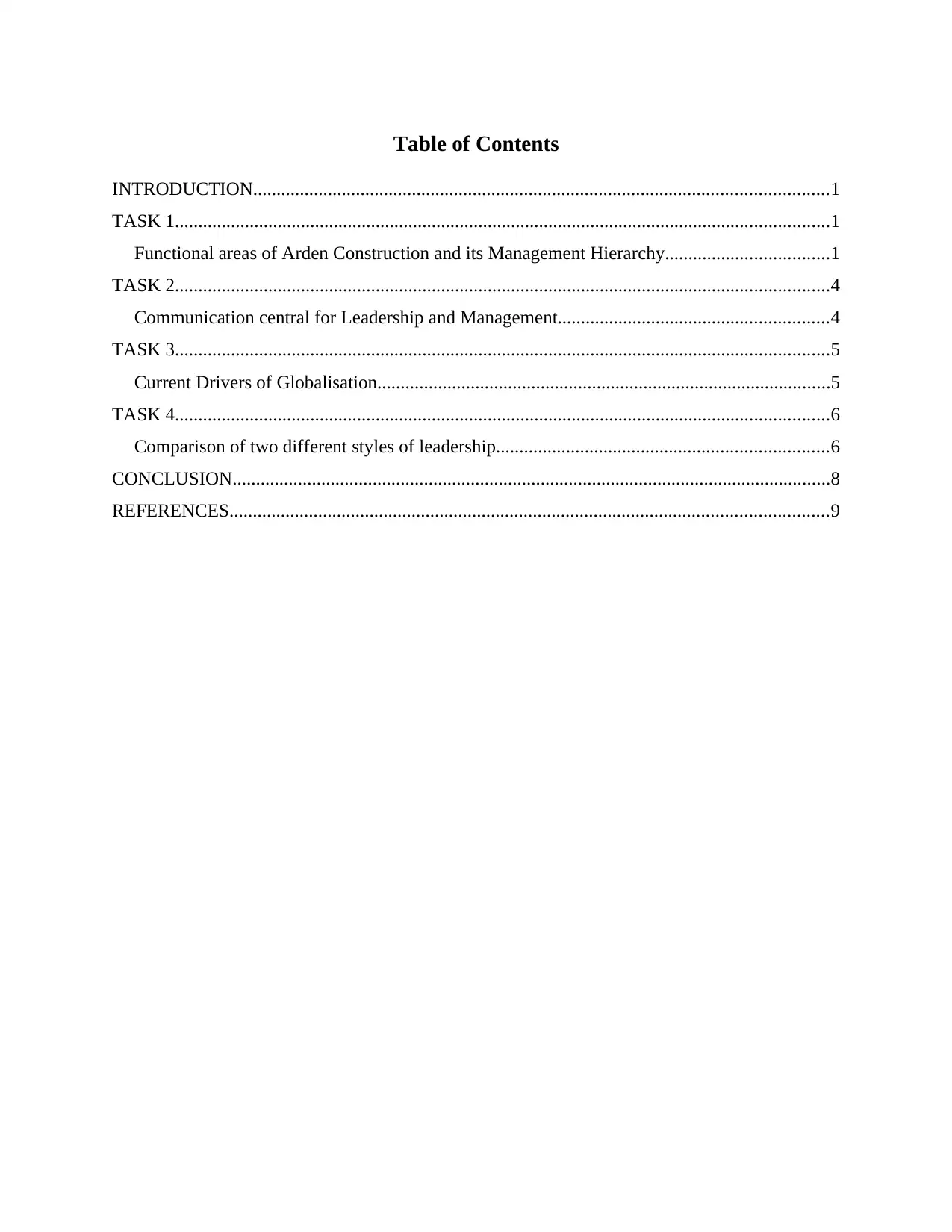
Table of Contents
INTRODUCTION...........................................................................................................................1
TASK 1............................................................................................................................................1
Functional areas of Arden Construction and its Management Hierarchy...................................1
TASK 2............................................................................................................................................4
Communication central for Leadership and Management..........................................................4
TASK 3............................................................................................................................................5
Current Drivers of Globalisation.................................................................................................5
TASK 4............................................................................................................................................6
Comparison of two different styles of leadership.......................................................................6
CONCLUSION................................................................................................................................8
REFERENCES................................................................................................................................9
INTRODUCTION...........................................................................................................................1
TASK 1............................................................................................................................................1
Functional areas of Arden Construction and its Management Hierarchy...................................1
TASK 2............................................................................................................................................4
Communication central for Leadership and Management..........................................................4
TASK 3............................................................................................................................................5
Current Drivers of Globalisation.................................................................................................5
TASK 4............................................................................................................................................6
Comparison of two different styles of leadership.......................................................................6
CONCLUSION................................................................................................................................8
REFERENCES................................................................................................................................9
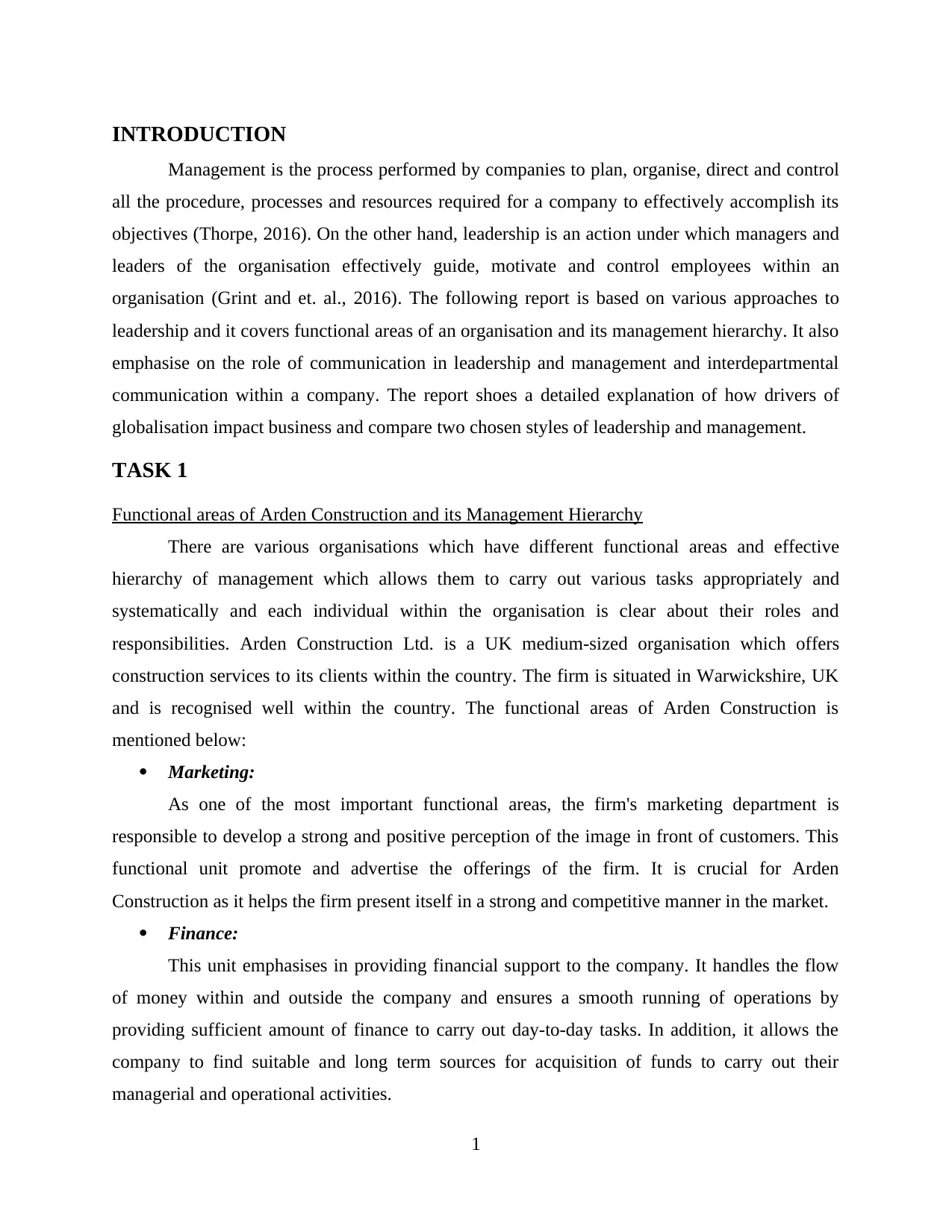
INTRODUCTION
Management is the process performed by companies to plan, organise, direct and control
all the procedure, processes and resources required for a company to effectively accomplish its
objectives (Thorpe, 2016). On the other hand, leadership is an action under which managers and
leaders of the organisation effectively guide, motivate and control employees within an
organisation (Grint and et. al., 2016). The following report is based on various approaches to
leadership and it covers functional areas of an organisation and its management hierarchy. It also
emphasise on the role of communication in leadership and management and interdepartmental
communication within a company. The report shoes a detailed explanation of how drivers of
globalisation impact business and compare two chosen styles of leadership and management.
TASK 1
Functional areas of Arden Construction and its Management Hierarchy
There are various organisations which have different functional areas and effective
hierarchy of management which allows them to carry out various tasks appropriately and
systematically and each individual within the organisation is clear about their roles and
responsibilities. Arden Construction Ltd. is a UK medium-sized organisation which offers
construction services to its clients within the country. The firm is situated in Warwickshire, UK
and is recognised well within the country. The functional areas of Arden Construction is
mentioned below:
Marketing:
As one of the most important functional areas, the firm's marketing department is
responsible to develop a strong and positive perception of the image in front of customers. This
functional unit promote and advertise the offerings of the firm. It is crucial for Arden
Construction as it helps the firm present itself in a strong and competitive manner in the market.
Finance:
This unit emphasises in providing financial support to the company. It handles the flow
of money within and outside the company and ensures a smooth running of operations by
providing sufficient amount of finance to carry out day-to-day tasks. In addition, it allows the
company to find suitable and long term sources for acquisition of funds to carry out their
managerial and operational activities.
1
Management is the process performed by companies to plan, organise, direct and control
all the procedure, processes and resources required for a company to effectively accomplish its
objectives (Thorpe, 2016). On the other hand, leadership is an action under which managers and
leaders of the organisation effectively guide, motivate and control employees within an
organisation (Grint and et. al., 2016). The following report is based on various approaches to
leadership and it covers functional areas of an organisation and its management hierarchy. It also
emphasise on the role of communication in leadership and management and interdepartmental
communication within a company. The report shoes a detailed explanation of how drivers of
globalisation impact business and compare two chosen styles of leadership and management.
TASK 1
Functional areas of Arden Construction and its Management Hierarchy
There are various organisations which have different functional areas and effective
hierarchy of management which allows them to carry out various tasks appropriately and
systematically and each individual within the organisation is clear about their roles and
responsibilities. Arden Construction Ltd. is a UK medium-sized organisation which offers
construction services to its clients within the country. The firm is situated in Warwickshire, UK
and is recognised well within the country. The functional areas of Arden Construction is
mentioned below:
Marketing:
As one of the most important functional areas, the firm's marketing department is
responsible to develop a strong and positive perception of the image in front of customers. This
functional unit promote and advertise the offerings of the firm. It is crucial for Arden
Construction as it helps the firm present itself in a strong and competitive manner in the market.
Finance:
This unit emphasises in providing financial support to the company. It handles the flow
of money within and outside the company and ensures a smooth running of operations by
providing sufficient amount of finance to carry out day-to-day tasks. In addition, it allows the
company to find suitable and long term sources for acquisition of funds to carry out their
managerial and operational activities.
1
⊘ This is a preview!⊘
Do you want full access?
Subscribe today to unlock all pages.

Trusted by 1+ million students worldwide
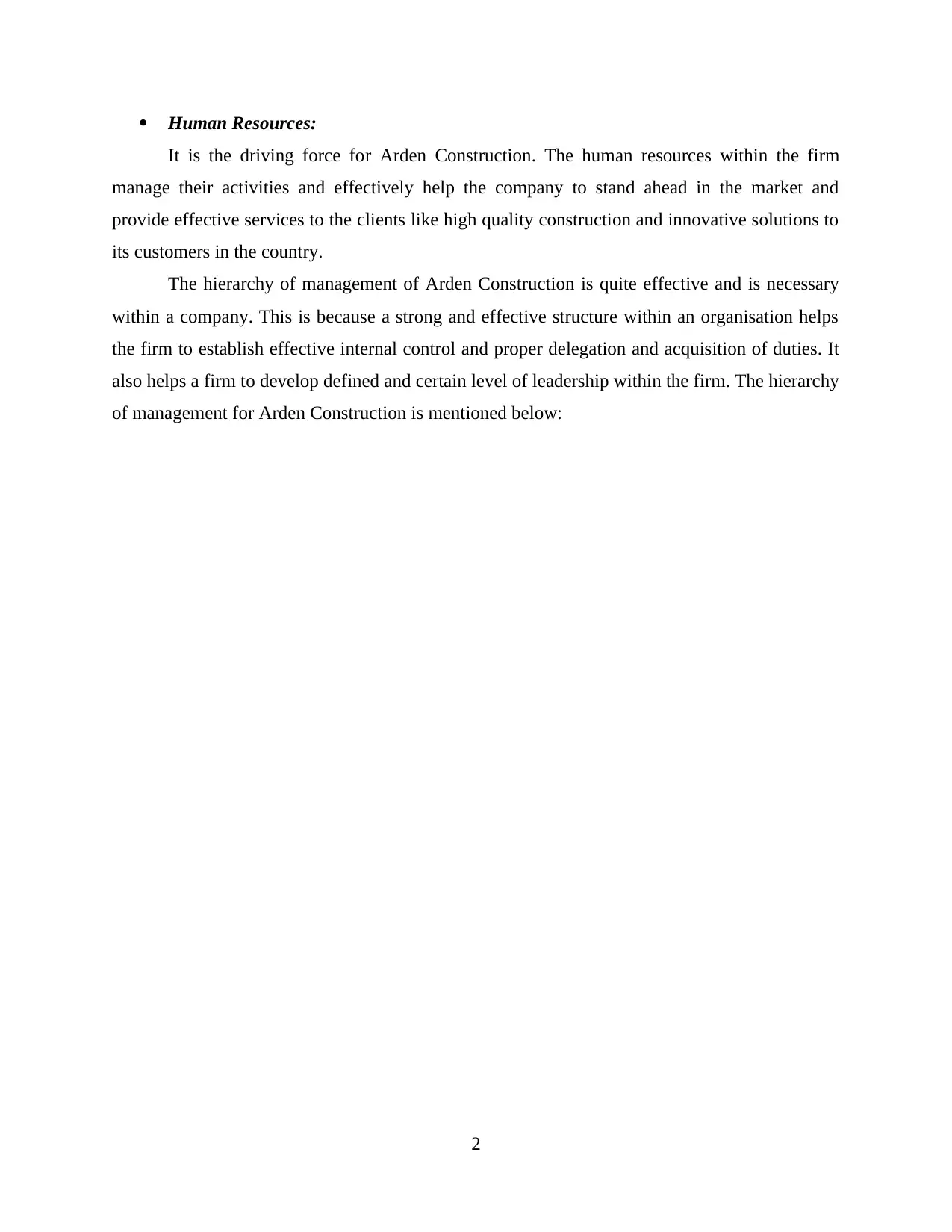
Human Resources:
It is the driving force for Arden Construction. The human resources within the firm
manage their activities and effectively help the company to stand ahead in the market and
provide effective services to the clients like high quality construction and innovative solutions to
its customers in the country.
The hierarchy of management of Arden Construction is quite effective and is necessary
within a company. This is because a strong and effective structure within an organisation helps
the firm to establish effective internal control and proper delegation and acquisition of duties. It
also helps a firm to develop defined and certain level of leadership within the firm. The hierarchy
of management for Arden Construction is mentioned below:
2
It is the driving force for Arden Construction. The human resources within the firm
manage their activities and effectively help the company to stand ahead in the market and
provide effective services to the clients like high quality construction and innovative solutions to
its customers in the country.
The hierarchy of management of Arden Construction is quite effective and is necessary
within a company. This is because a strong and effective structure within an organisation helps
the firm to establish effective internal control and proper delegation and acquisition of duties. It
also helps a firm to develop defined and certain level of leadership within the firm. The hierarchy
of management for Arden Construction is mentioned below:
2
Paraphrase This Document
Need a fresh take? Get an instant paraphrase of this document with our AI Paraphraser
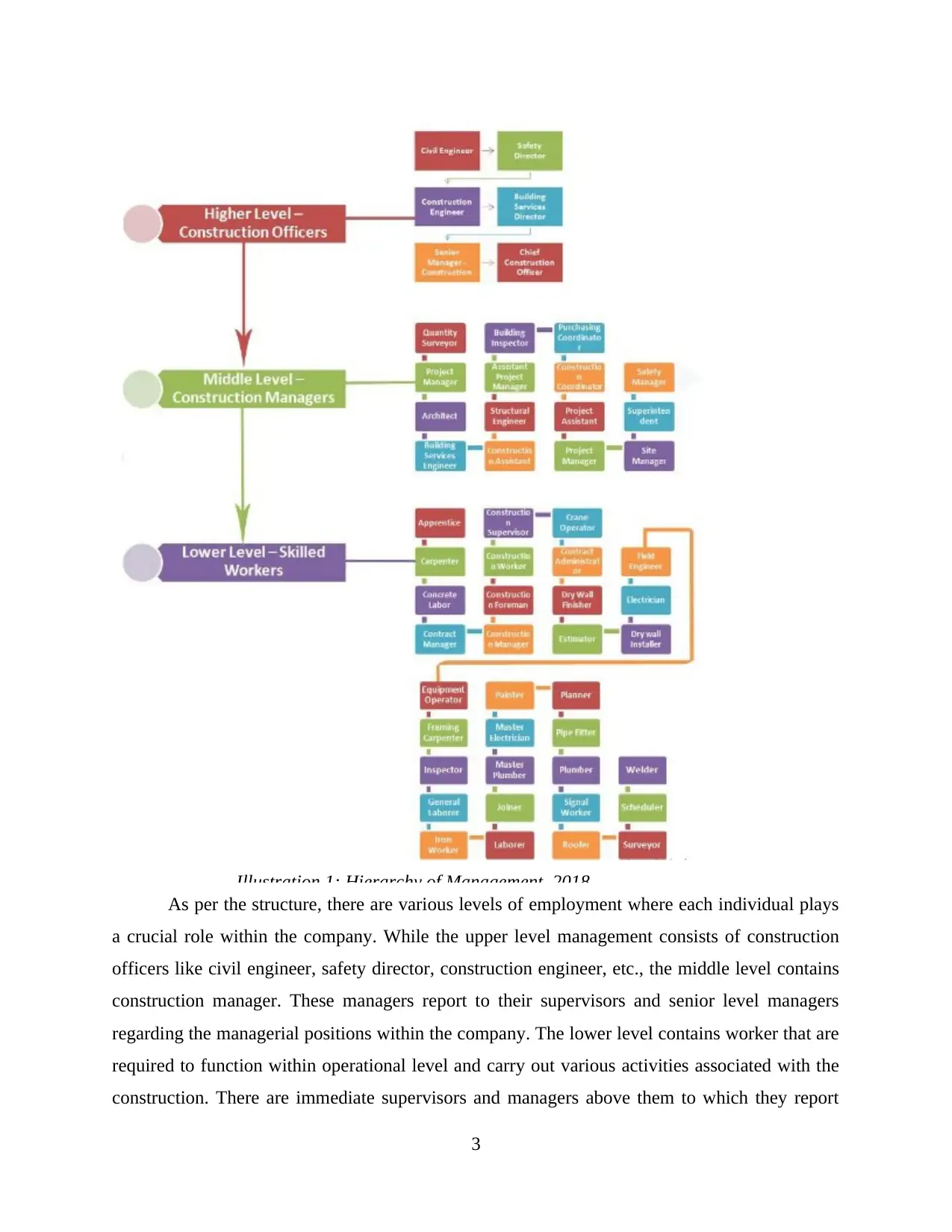
Illustration 1: Hierarchy of Management, 2018
As per the structure, there are various levels of employment where each individual plays
a crucial role within the company. While the upper level management consists of construction
officers like civil engineer, safety director, construction engineer, etc., the middle level contains
construction manager. These managers report to their supervisors and senior level managers
regarding the managerial positions within the company. The lower level contains worker that are
required to function within operational level and carry out various activities associated with the
construction. There are immediate supervisors and managers above them to which they report
3
As per the structure, there are various levels of employment where each individual plays
a crucial role within the company. While the upper level management consists of construction
officers like civil engineer, safety director, construction engineer, etc., the middle level contains
construction manager. These managers report to their supervisors and senior level managers
regarding the managerial positions within the company. The lower level contains worker that are
required to function within operational level and carry out various activities associated with the
construction. There are immediate supervisors and managers above them to which they report
3
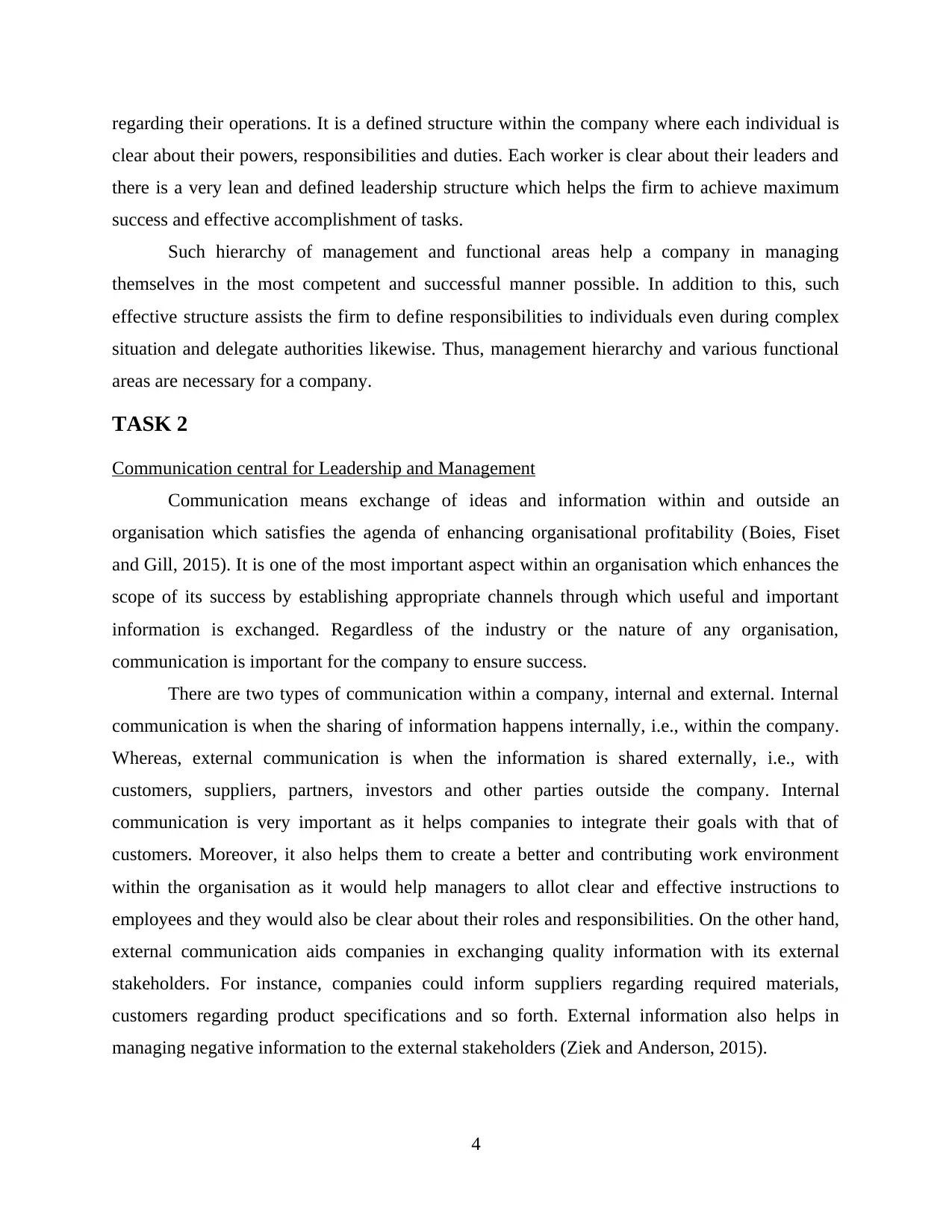
regarding their operations. It is a defined structure within the company where each individual is
clear about their powers, responsibilities and duties. Each worker is clear about their leaders and
there is a very lean and defined leadership structure which helps the firm to achieve maximum
success and effective accomplishment of tasks.
Such hierarchy of management and functional areas help a company in managing
themselves in the most competent and successful manner possible. In addition to this, such
effective structure assists the firm to define responsibilities to individuals even during complex
situation and delegate authorities likewise. Thus, management hierarchy and various functional
areas are necessary for a company.
TASK 2
Communication central for Leadership and Management
Communication means exchange of ideas and information within and outside an
organisation which satisfies the agenda of enhancing organisational profitability (Boies, Fiset
and Gill, 2015). It is one of the most important aspect within an organisation which enhances the
scope of its success by establishing appropriate channels through which useful and important
information is exchanged. Regardless of the industry or the nature of any organisation,
communication is important for the company to ensure success.
There are two types of communication within a company, internal and external. Internal
communication is when the sharing of information happens internally, i.e., within the company.
Whereas, external communication is when the information is shared externally, i.e., with
customers, suppliers, partners, investors and other parties outside the company. Internal
communication is very important as it helps companies to integrate their goals with that of
customers. Moreover, it also helps them to create a better and contributing work environment
within the organisation as it would help managers to allot clear and effective instructions to
employees and they would also be clear about their roles and responsibilities. On the other hand,
external communication aids companies in exchanging quality information with its external
stakeholders. For instance, companies could inform suppliers regarding required materials,
customers regarding product specifications and so forth. External information also helps in
managing negative information to the external stakeholders (Ziek and Anderson, 2015).
4
clear about their powers, responsibilities and duties. Each worker is clear about their leaders and
there is a very lean and defined leadership structure which helps the firm to achieve maximum
success and effective accomplishment of tasks.
Such hierarchy of management and functional areas help a company in managing
themselves in the most competent and successful manner possible. In addition to this, such
effective structure assists the firm to define responsibilities to individuals even during complex
situation and delegate authorities likewise. Thus, management hierarchy and various functional
areas are necessary for a company.
TASK 2
Communication central for Leadership and Management
Communication means exchange of ideas and information within and outside an
organisation which satisfies the agenda of enhancing organisational profitability (Boies, Fiset
and Gill, 2015). It is one of the most important aspect within an organisation which enhances the
scope of its success by establishing appropriate channels through which useful and important
information is exchanged. Regardless of the industry or the nature of any organisation,
communication is important for the company to ensure success.
There are two types of communication within a company, internal and external. Internal
communication is when the sharing of information happens internally, i.e., within the company.
Whereas, external communication is when the information is shared externally, i.e., with
customers, suppliers, partners, investors and other parties outside the company. Internal
communication is very important as it helps companies to integrate their goals with that of
customers. Moreover, it also helps them to create a better and contributing work environment
within the organisation as it would help managers to allot clear and effective instructions to
employees and they would also be clear about their roles and responsibilities. On the other hand,
external communication aids companies in exchanging quality information with its external
stakeholders. For instance, companies could inform suppliers regarding required materials,
customers regarding product specifications and so forth. External information also helps in
managing negative information to the external stakeholders (Ziek and Anderson, 2015).
4
⊘ This is a preview!⊘
Do you want full access?
Subscribe today to unlock all pages.

Trusted by 1+ million students worldwide
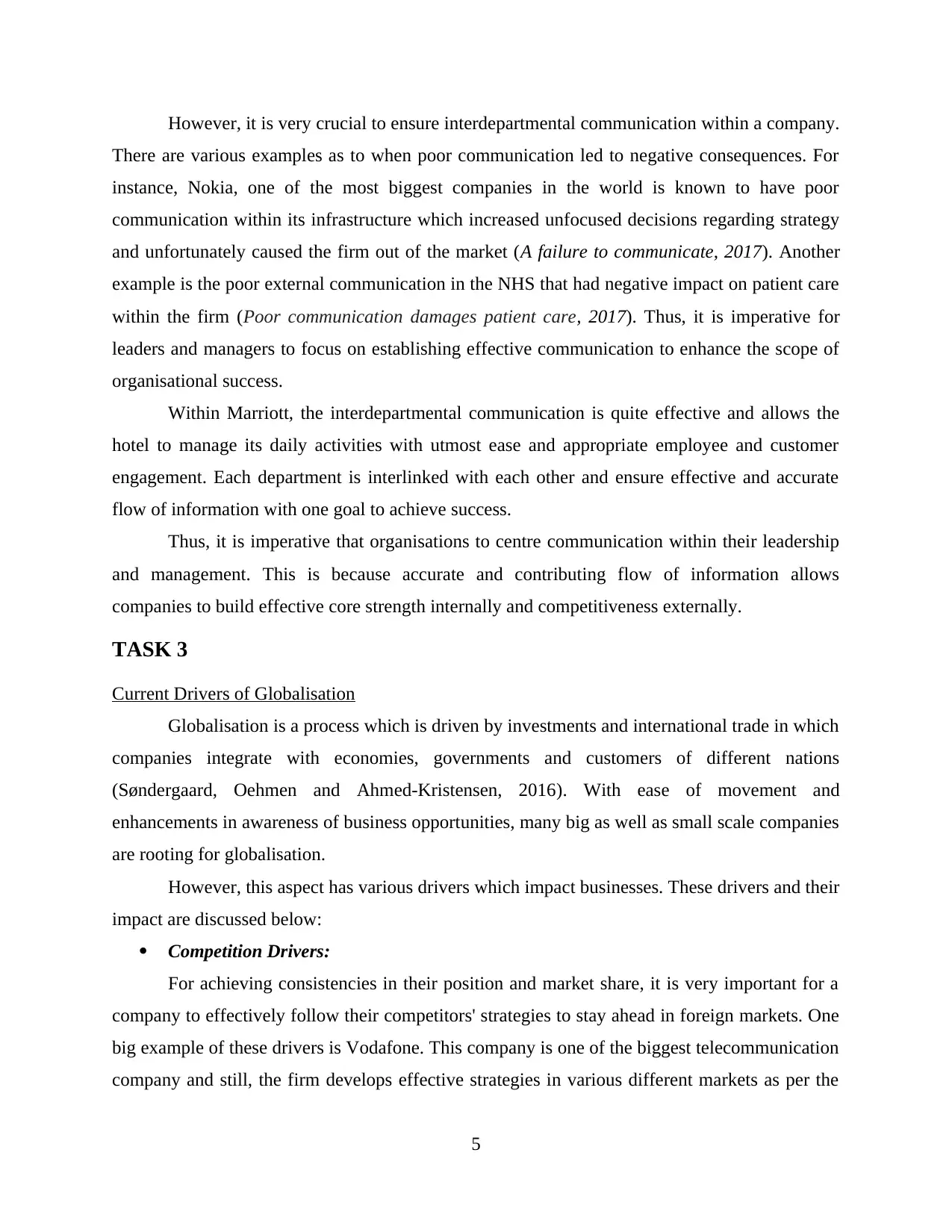
However, it is very crucial to ensure interdepartmental communication within a company.
There are various examples as to when poor communication led to negative consequences. For
instance, Nokia, one of the most biggest companies in the world is known to have poor
communication within its infrastructure which increased unfocused decisions regarding strategy
and unfortunately caused the firm out of the market (A failure to communicate, 2017). Another
example is the poor external communication in the NHS that had negative impact on patient care
within the firm (Poor communication damages patient care, 2017). Thus, it is imperative for
leaders and managers to focus on establishing effective communication to enhance the scope of
organisational success.
Within Marriott, the interdepartmental communication is quite effective and allows the
hotel to manage its daily activities with utmost ease and appropriate employee and customer
engagement. Each department is interlinked with each other and ensure effective and accurate
flow of information with one goal to achieve success.
Thus, it is imperative that organisations to centre communication within their leadership
and management. This is because accurate and contributing flow of information allows
companies to build effective core strength internally and competitiveness externally.
TASK 3
Current Drivers of Globalisation
Globalisation is a process which is driven by investments and international trade in which
companies integrate with economies, governments and customers of different nations
(Søndergaard, Oehmen and Ahmed-Kristensen, 2016). With ease of movement and
enhancements in awareness of business opportunities, many big as well as small scale companies
are rooting for globalisation.
However, this aspect has various drivers which impact businesses. These drivers and their
impact are discussed below:
Competition Drivers:
For achieving consistencies in their position and market share, it is very important for a
company to effectively follow their competitors' strategies to stay ahead in foreign markets. One
big example of these drivers is Vodafone. This company is one of the biggest telecommunication
company and still, the firm develops effective strategies in various different markets as per the
5
There are various examples as to when poor communication led to negative consequences. For
instance, Nokia, one of the most biggest companies in the world is known to have poor
communication within its infrastructure which increased unfocused decisions regarding strategy
and unfortunately caused the firm out of the market (A failure to communicate, 2017). Another
example is the poor external communication in the NHS that had negative impact on patient care
within the firm (Poor communication damages patient care, 2017). Thus, it is imperative for
leaders and managers to focus on establishing effective communication to enhance the scope of
organisational success.
Within Marriott, the interdepartmental communication is quite effective and allows the
hotel to manage its daily activities with utmost ease and appropriate employee and customer
engagement. Each department is interlinked with each other and ensure effective and accurate
flow of information with one goal to achieve success.
Thus, it is imperative that organisations to centre communication within their leadership
and management. This is because accurate and contributing flow of information allows
companies to build effective core strength internally and competitiveness externally.
TASK 3
Current Drivers of Globalisation
Globalisation is a process which is driven by investments and international trade in which
companies integrate with economies, governments and customers of different nations
(Søndergaard, Oehmen and Ahmed-Kristensen, 2016). With ease of movement and
enhancements in awareness of business opportunities, many big as well as small scale companies
are rooting for globalisation.
However, this aspect has various drivers which impact businesses. These drivers and their
impact are discussed below:
Competition Drivers:
For achieving consistencies in their position and market share, it is very important for a
company to effectively follow their competitors' strategies to stay ahead in foreign markets. One
big example of these drivers is Vodafone. This company is one of the biggest telecommunication
company and still, the firm develops effective strategies in various different markets as per the
5
Paraphrase This Document
Need a fresh take? Get an instant paraphrase of this document with our AI Paraphraser
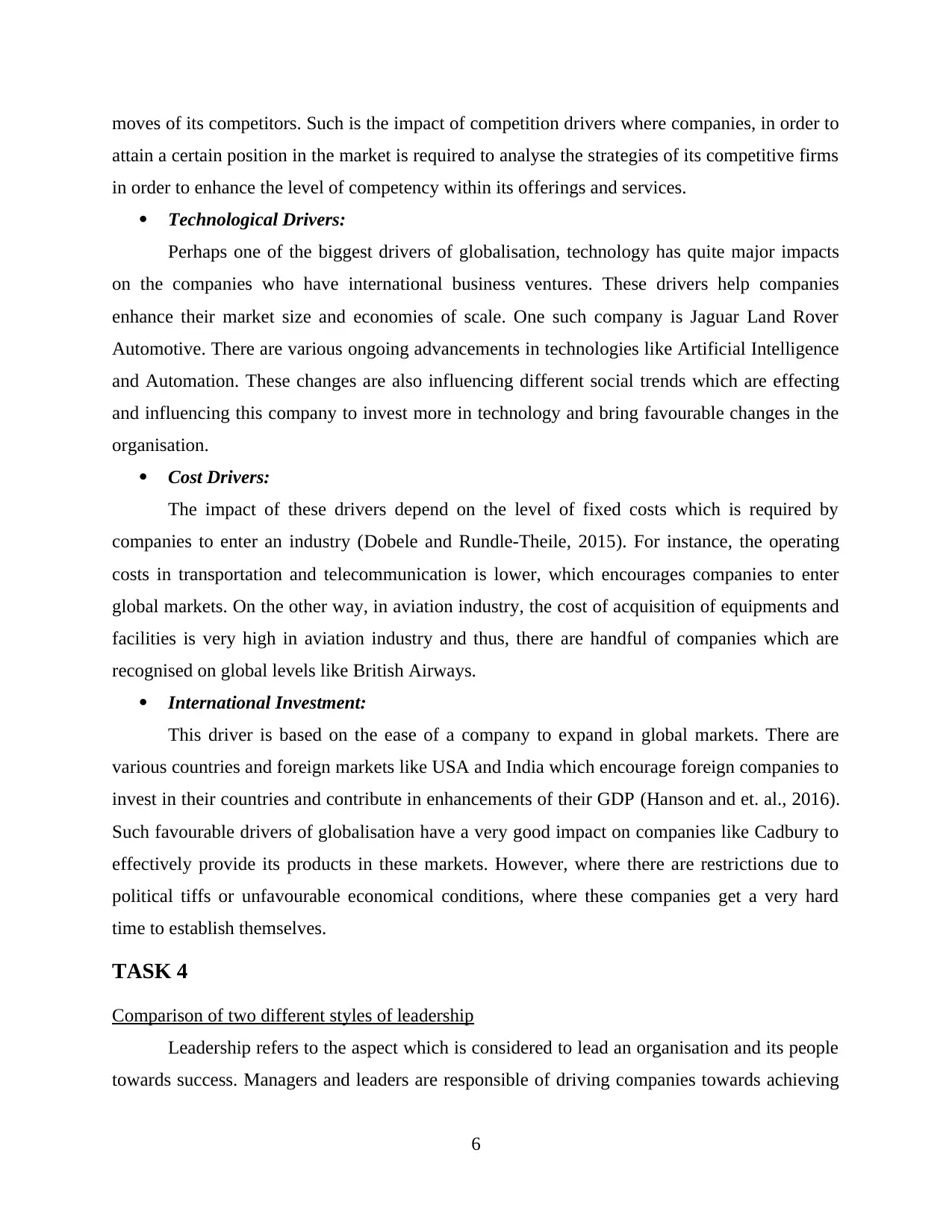
moves of its competitors. Such is the impact of competition drivers where companies, in order to
attain a certain position in the market is required to analyse the strategies of its competitive firms
in order to enhance the level of competency within its offerings and services.
Technological Drivers:
Perhaps one of the biggest drivers of globalisation, technology has quite major impacts
on the companies who have international business ventures. These drivers help companies
enhance their market size and economies of scale. One such company is Jaguar Land Rover
Automotive. There are various ongoing advancements in technologies like Artificial Intelligence
and Automation. These changes are also influencing different social trends which are effecting
and influencing this company to invest more in technology and bring favourable changes in the
organisation.
Cost Drivers:
The impact of these drivers depend on the level of fixed costs which is required by
companies to enter an industry (Dobele and Rundle‐Theile, 2015). For instance, the operating
costs in transportation and telecommunication is lower, which encourages companies to enter
global markets. On the other way, in aviation industry, the cost of acquisition of equipments and
facilities is very high in aviation industry and thus, there are handful of companies which are
recognised on global levels like British Airways.
International Investment:
This driver is based on the ease of a company to expand in global markets. There are
various countries and foreign markets like USA and India which encourage foreign companies to
invest in their countries and contribute in enhancements of their GDP (Hanson and et. al., 2016).
Such favourable drivers of globalisation have a very good impact on companies like Cadbury to
effectively provide its products in these markets. However, where there are restrictions due to
political tiffs or unfavourable economical conditions, where these companies get a very hard
time to establish themselves.
TASK 4
Comparison of two different styles of leadership
Leadership refers to the aspect which is considered to lead an organisation and its people
towards success. Managers and leaders are responsible of driving companies towards achieving
6
attain a certain position in the market is required to analyse the strategies of its competitive firms
in order to enhance the level of competency within its offerings and services.
Technological Drivers:
Perhaps one of the biggest drivers of globalisation, technology has quite major impacts
on the companies who have international business ventures. These drivers help companies
enhance their market size and economies of scale. One such company is Jaguar Land Rover
Automotive. There are various ongoing advancements in technologies like Artificial Intelligence
and Automation. These changes are also influencing different social trends which are effecting
and influencing this company to invest more in technology and bring favourable changes in the
organisation.
Cost Drivers:
The impact of these drivers depend on the level of fixed costs which is required by
companies to enter an industry (Dobele and Rundle‐Theile, 2015). For instance, the operating
costs in transportation and telecommunication is lower, which encourages companies to enter
global markets. On the other way, in aviation industry, the cost of acquisition of equipments and
facilities is very high in aviation industry and thus, there are handful of companies which are
recognised on global levels like British Airways.
International Investment:
This driver is based on the ease of a company to expand in global markets. There are
various countries and foreign markets like USA and India which encourage foreign companies to
invest in their countries and contribute in enhancements of their GDP (Hanson and et. al., 2016).
Such favourable drivers of globalisation have a very good impact on companies like Cadbury to
effectively provide its products in these markets. However, where there are restrictions due to
political tiffs or unfavourable economical conditions, where these companies get a very hard
time to establish themselves.
TASK 4
Comparison of two different styles of leadership
Leadership refers to the aspect which is considered to lead an organisation and its people
towards success. Managers and leaders are responsible of driving companies towards achieving
6
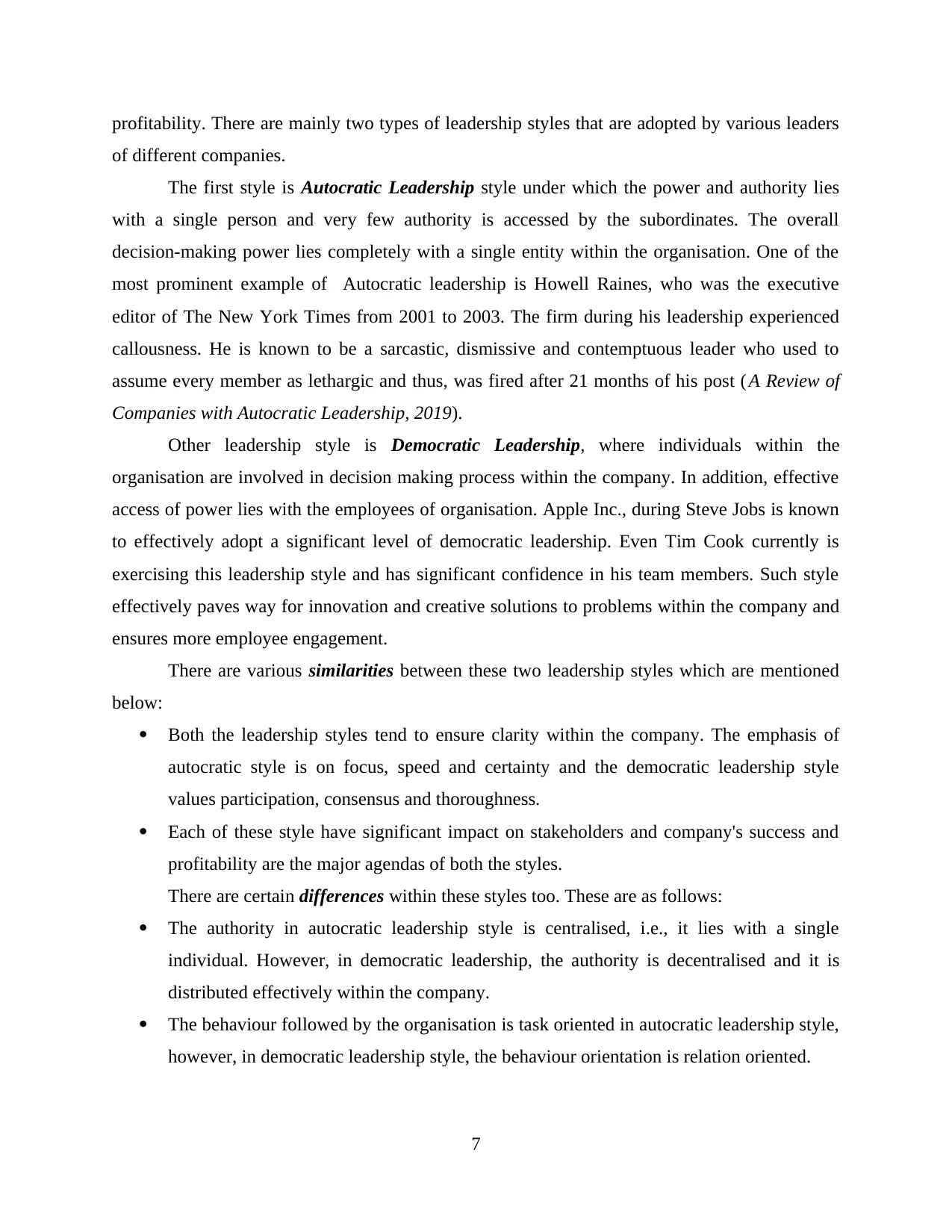
profitability. There are mainly two types of leadership styles that are adopted by various leaders
of different companies.
The first style is Autocratic Leadership style under which the power and authority lies
with a single person and very few authority is accessed by the subordinates. The overall
decision-making power lies completely with a single entity within the organisation. One of the
most prominent example of Autocratic leadership is Howell Raines, who was the executive
editor of The New York Times from 2001 to 2003. The firm during his leadership experienced
callousness. He is known to be a sarcastic, dismissive and contemptuous leader who used to
assume every member as lethargic and thus, was fired after 21 months of his post ( A Review of
Companies with Autocratic Leadership, 2019).
Other leadership style is Democratic Leadership, where individuals within the
organisation are involved in decision making process within the company. In addition, effective
access of power lies with the employees of organisation. Apple Inc., during Steve Jobs is known
to effectively adopt a significant level of democratic leadership. Even Tim Cook currently is
exercising this leadership style and has significant confidence in his team members. Such style
effectively paves way for innovation and creative solutions to problems within the company and
ensures more employee engagement.
There are various similarities between these two leadership styles which are mentioned
below:
Both the leadership styles tend to ensure clarity within the company. The emphasis of
autocratic style is on focus, speed and certainty and the democratic leadership style
values participation, consensus and thoroughness.
Each of these style have significant impact on stakeholders and company's success and
profitability are the major agendas of both the styles.
There are certain differences within these styles too. These are as follows:
The authority in autocratic leadership style is centralised, i.e., it lies with a single
individual. However, in democratic leadership, the authority is decentralised and it is
distributed effectively within the company.
The behaviour followed by the organisation is task oriented in autocratic leadership style,
however, in democratic leadership style, the behaviour orientation is relation oriented.
7
of different companies.
The first style is Autocratic Leadership style under which the power and authority lies
with a single person and very few authority is accessed by the subordinates. The overall
decision-making power lies completely with a single entity within the organisation. One of the
most prominent example of Autocratic leadership is Howell Raines, who was the executive
editor of The New York Times from 2001 to 2003. The firm during his leadership experienced
callousness. He is known to be a sarcastic, dismissive and contemptuous leader who used to
assume every member as lethargic and thus, was fired after 21 months of his post ( A Review of
Companies with Autocratic Leadership, 2019).
Other leadership style is Democratic Leadership, where individuals within the
organisation are involved in decision making process within the company. In addition, effective
access of power lies with the employees of organisation. Apple Inc., during Steve Jobs is known
to effectively adopt a significant level of democratic leadership. Even Tim Cook currently is
exercising this leadership style and has significant confidence in his team members. Such style
effectively paves way for innovation and creative solutions to problems within the company and
ensures more employee engagement.
There are various similarities between these two leadership styles which are mentioned
below:
Both the leadership styles tend to ensure clarity within the company. The emphasis of
autocratic style is on focus, speed and certainty and the democratic leadership style
values participation, consensus and thoroughness.
Each of these style have significant impact on stakeholders and company's success and
profitability are the major agendas of both the styles.
There are certain differences within these styles too. These are as follows:
The authority in autocratic leadership style is centralised, i.e., it lies with a single
individual. However, in democratic leadership, the authority is decentralised and it is
distributed effectively within the company.
The behaviour followed by the organisation is task oriented in autocratic leadership style,
however, in democratic leadership style, the behaviour orientation is relation oriented.
7
⊘ This is a preview!⊘
Do you want full access?
Subscribe today to unlock all pages.

Trusted by 1+ million students worldwide
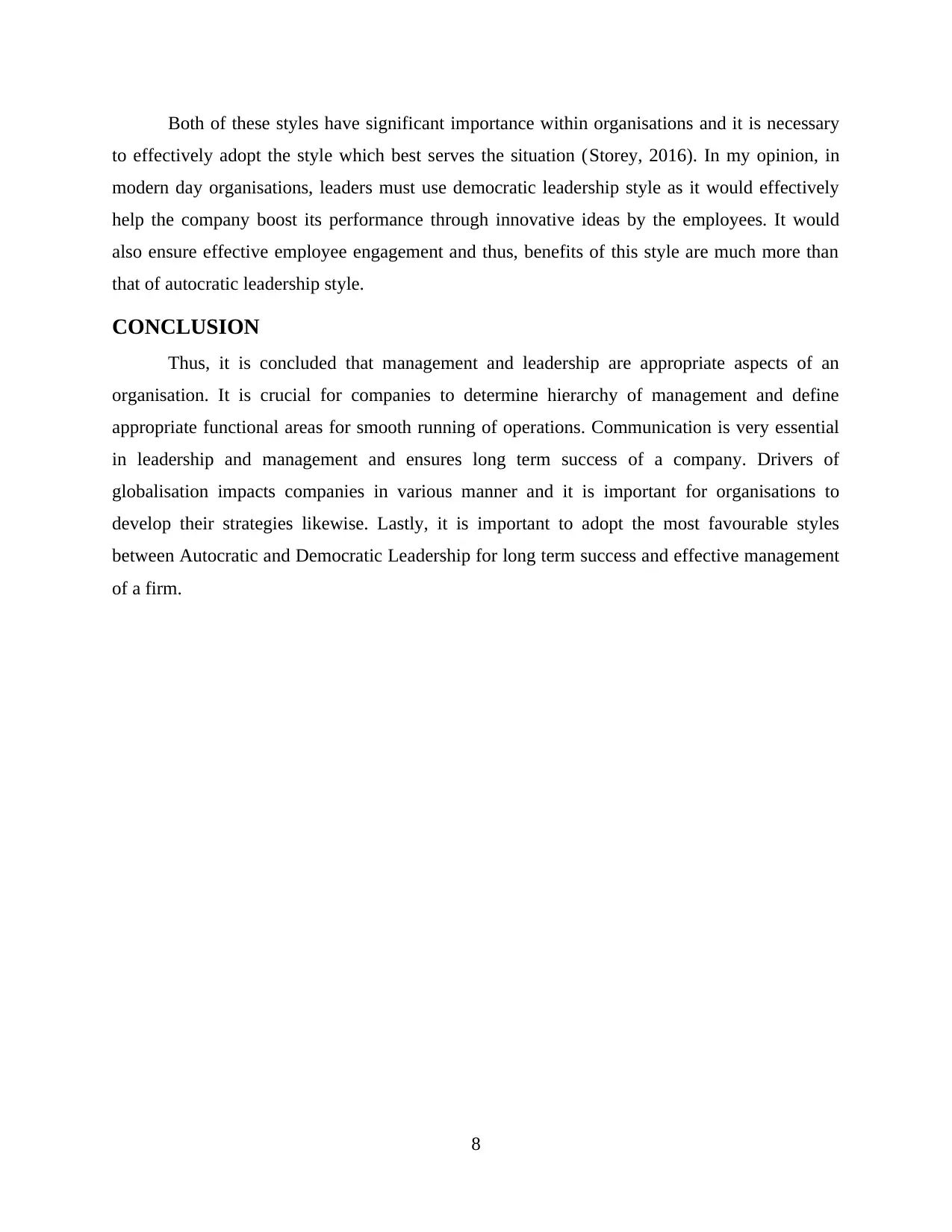
Both of these styles have significant importance within organisations and it is necessary
to effectively adopt the style which best serves the situation (Storey, 2016). In my opinion, in
modern day organisations, leaders must use democratic leadership style as it would effectively
help the company boost its performance through innovative ideas by the employees. It would
also ensure effective employee engagement and thus, benefits of this style are much more than
that of autocratic leadership style.
CONCLUSION
Thus, it is concluded that management and leadership are appropriate aspects of an
organisation. It is crucial for companies to determine hierarchy of management and define
appropriate functional areas for smooth running of operations. Communication is very essential
in leadership and management and ensures long term success of a company. Drivers of
globalisation impacts companies in various manner and it is important for organisations to
develop their strategies likewise. Lastly, it is important to adopt the most favourable styles
between Autocratic and Democratic Leadership for long term success and effective management
of a firm.
8
to effectively adopt the style which best serves the situation (Storey, 2016). In my opinion, in
modern day organisations, leaders must use democratic leadership style as it would effectively
help the company boost its performance through innovative ideas by the employees. It would
also ensure effective employee engagement and thus, benefits of this style are much more than
that of autocratic leadership style.
CONCLUSION
Thus, it is concluded that management and leadership are appropriate aspects of an
organisation. It is crucial for companies to determine hierarchy of management and define
appropriate functional areas for smooth running of operations. Communication is very essential
in leadership and management and ensures long term success of a company. Drivers of
globalisation impacts companies in various manner and it is important for organisations to
develop their strategies likewise. Lastly, it is important to adopt the most favourable styles
between Autocratic and Democratic Leadership for long term success and effective management
of a firm.
8
Paraphrase This Document
Need a fresh take? Get an instant paraphrase of this document with our AI Paraphraser
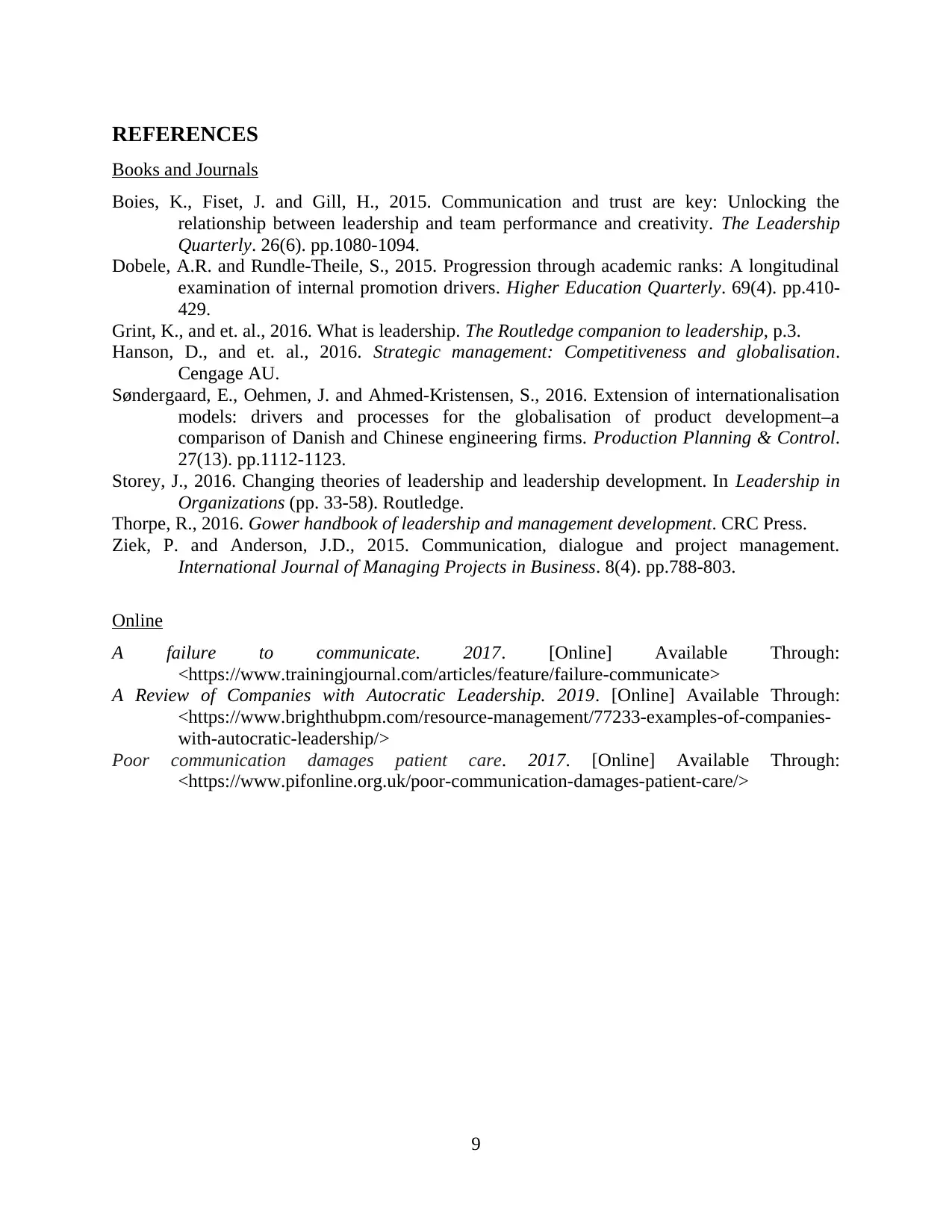
REFERENCES
Books and Journals
Boies, K., Fiset, J. and Gill, H., 2015. Communication and trust are key: Unlocking the
relationship between leadership and team performance and creativity. The Leadership
Quarterly. 26(6). pp.1080-1094.
Dobele, A.R. and Rundle‐Theile, S., 2015. Progression through academic ranks: A longitudinal
examination of internal promotion drivers. Higher Education Quarterly. 69(4). pp.410-
429.
Grint, K., and et. al., 2016. What is leadership. The Routledge companion to leadership, p.3.
Hanson, D., and et. al., 2016. Strategic management: Competitiveness and globalisation.
Cengage AU.
Søndergaard, E., Oehmen, J. and Ahmed-Kristensen, S., 2016. Extension of internationalisation
models: drivers and processes for the globalisation of product development–a
comparison of Danish and Chinese engineering firms. Production Planning & Control.
27(13). pp.1112-1123.
Storey, J., 2016. Changing theories of leadership and leadership development. In Leadership in
Organizations (pp. 33-58). Routledge.
Thorpe, R., 2016. Gower handbook of leadership and management development. CRC Press.
Ziek, P. and Anderson, J.D., 2015. Communication, dialogue and project management.
International Journal of Managing Projects in Business. 8(4). pp.788-803.
Online
A failure to communicate. 2017. [Online] Available Through:
<https://www.trainingjournal.com/articles/feature/failure-communicate>
A Review of Companies with Autocratic Leadership. 2019. [Online] Available Through:
<https://www.brighthubpm.com/resource-management/77233-examples-of-companies-
with-autocratic-leadership/>
Poor communication damages patient care. 2017. [Online] Available Through:
<https://www.pifonline.org.uk/poor-communication-damages-patient-care/>
9
Books and Journals
Boies, K., Fiset, J. and Gill, H., 2015. Communication and trust are key: Unlocking the
relationship between leadership and team performance and creativity. The Leadership
Quarterly. 26(6). pp.1080-1094.
Dobele, A.R. and Rundle‐Theile, S., 2015. Progression through academic ranks: A longitudinal
examination of internal promotion drivers. Higher Education Quarterly. 69(4). pp.410-
429.
Grint, K., and et. al., 2016. What is leadership. The Routledge companion to leadership, p.3.
Hanson, D., and et. al., 2016. Strategic management: Competitiveness and globalisation.
Cengage AU.
Søndergaard, E., Oehmen, J. and Ahmed-Kristensen, S., 2016. Extension of internationalisation
models: drivers and processes for the globalisation of product development–a
comparison of Danish and Chinese engineering firms. Production Planning & Control.
27(13). pp.1112-1123.
Storey, J., 2016. Changing theories of leadership and leadership development. In Leadership in
Organizations (pp. 33-58). Routledge.
Thorpe, R., 2016. Gower handbook of leadership and management development. CRC Press.
Ziek, P. and Anderson, J.D., 2015. Communication, dialogue and project management.
International Journal of Managing Projects in Business. 8(4). pp.788-803.
Online
A failure to communicate. 2017. [Online] Available Through:
<https://www.trainingjournal.com/articles/feature/failure-communicate>
A Review of Companies with Autocratic Leadership. 2019. [Online] Available Through:
<https://www.brighthubpm.com/resource-management/77233-examples-of-companies-
with-autocratic-leadership/>
Poor communication damages patient care. 2017. [Online] Available Through:
<https://www.pifonline.org.uk/poor-communication-damages-patient-care/>
9
1 out of 11
Related Documents
Your All-in-One AI-Powered Toolkit for Academic Success.
+13062052269
info@desklib.com
Available 24*7 on WhatsApp / Email
![[object Object]](/_next/static/media/star-bottom.7253800d.svg)
Unlock your academic potential
Copyright © 2020–2025 A2Z Services. All Rights Reserved. Developed and managed by ZUCOL.




